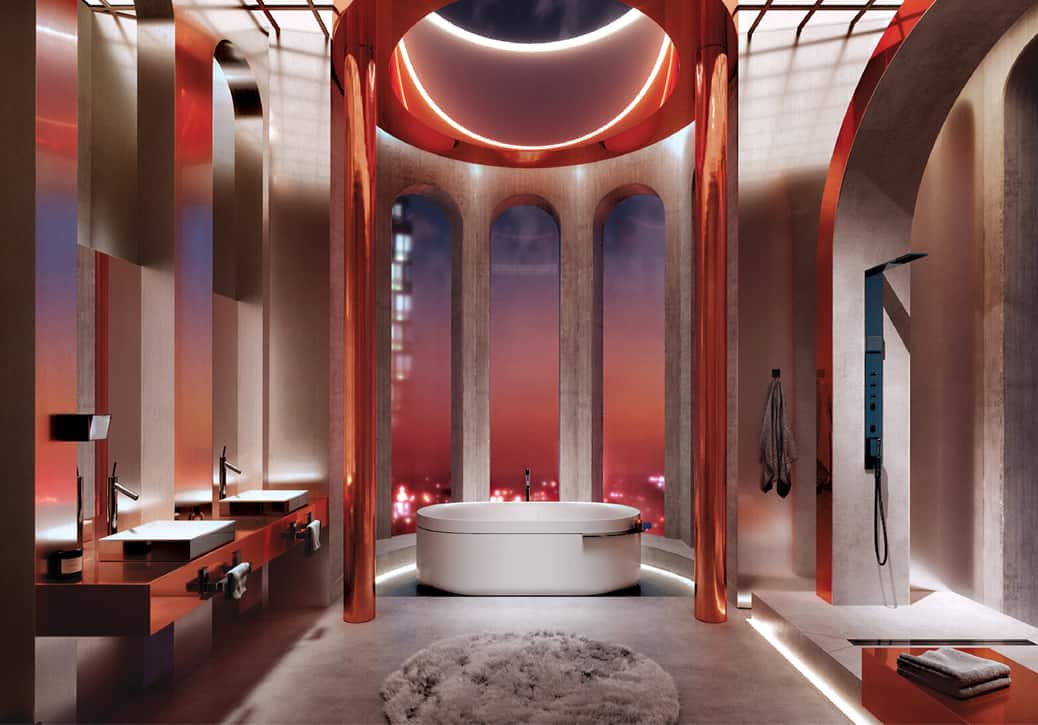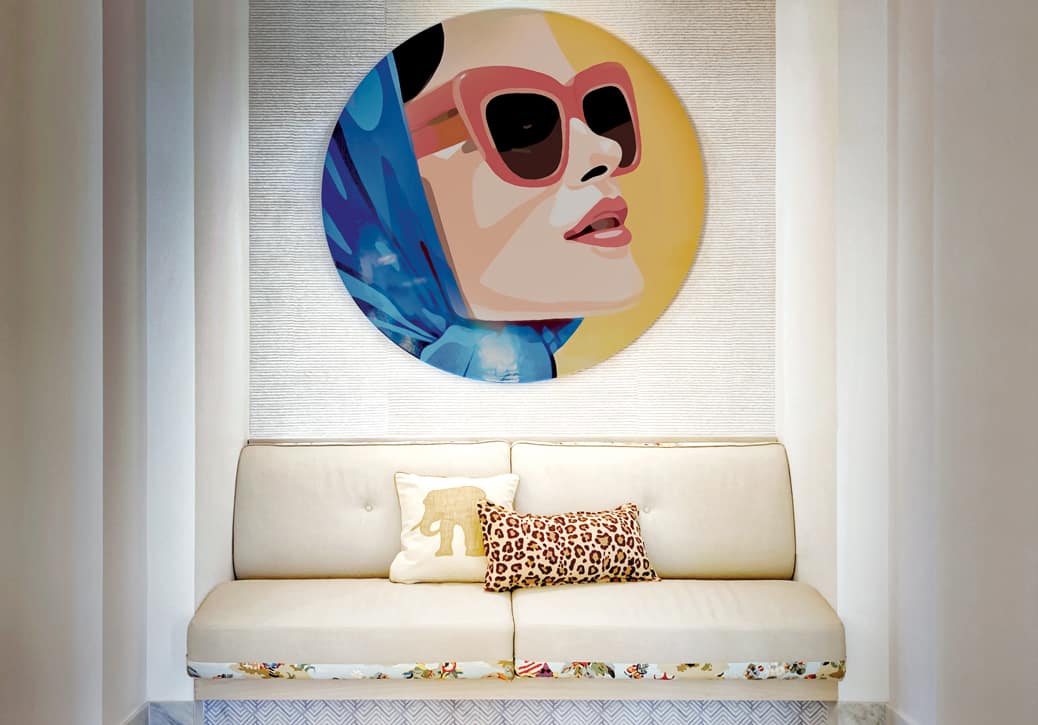 A chat with Mario Buatta
A chat with Mario Buatta
By Shelley M. Black
Called a legend by many—including Paige Rense, former editor and doyenne of Architectural Digest—Mario Buatta has been synonymous with good taste in the world of New York décor for decades. So why has it taken 50 years for him to publish the first book of his work? We caught up with the “Prince of Chintz” in his Manhattan home to find out.
 Q. Why did you decide to finally publish a book?
Q. Why did you decide to finally publish a book?
Mario: In the old days, decorators didn’t do books. Billy Baldwin didn’t do one until he was 77. I’ve always had offers and then, when my 50-year milestone came, I thought maybe I should get on with it. The book was supposed to be a mere 300 pages, but the president of Rizzoli conceded I needed more and gave me a hundred extra pages. I call it the Buatta-pedia.
Q. You’ve been called the “Prince of Chintz.” Has that design style come and gone, or is it still alive?
Mario: That name was given to me by Chauncey Howell in 1984. There is a painting of a blue and white bed-room in my book [page 223]—that’s the room that started it all. Howell was on Channel 7, Live at 5, when he started looking around the Kips Bay Decorator Show House room that I had created and said, “Chintz, chintz, prints, prints, prints.” It was a very catchy phrase that never went away.
Young people don’t really under-stand prints like those you see in English country houses. By using chintz and sisal carpets, I play down the grandiosity of things to make them liveable. To youngsters, a large room done in prints might look like an intimidating museum if the thinking behind it isn’t clear.
People today are starting to use bolder prints again, but many of the older specialty firms that were my suppliers have gone.
Q. You’ve done many amazing projects over the years for socialites and celebrities.
Mario: I’ve been very lucky. About 50 years ago, I was doing apartments for Broadway actresses such as Elaine Stritch. She wanted everything I had done for a friend of hers, but then she didn’t really like what I suggested. She was very challenging to work for. An amazingly talented woman, but difficult.
Mariah Carey still goes on about the apartment I did for her 10 years ago. She was very happy and that makes me happy. Mariah was on the phone the other night—she wants me to take care of a few things that need some updating. The thing about working with people in show business is that they really aren’t there all the time; they are travelling, rehearsing and performing. I hope to catch all my clients at a time when they are not too tired and can make decisions.
Q. How have your clients changed in the past 50 years?
Mario: They really haven’t. Now I work for the grandchildren and even great-grandchildren of previous clients. What has changed is the business: What you see in magazines is white and grey. I remember House Beautiful saying white and grey were going to be big for the ’90s and we’re still there today.
Today, everybody is a decorator. Even my clients are decorators. They see it all on the internet and they want it yesterday. People search 1stDibs and other online shops. They know where everything is. If they want a red cabinet, they’ll show me five that they’ve found. That’s a huge change.
They don’t want real silver or brown wood, or anything they have to take care of. There are no creature comforts, no family possessions, no relationships from the past. I’m so glad I’m at the other end of my career.
Q. Who or what inspires you in your life today?
Mario: Still everything from the past. I’m not inspired at all by what they call art today. You draw one line on a canvas and suddenly you’re an artist. I really don’t get it. For me it’s truly Matisse, Bonnard, Kenneth Noland… Their colours!
 Q. How did you get your start in the business?
Q. How did you get your start in the business?
Mario: My uncle was an architect and my grandfather hoped I would be the next one in the family. It’s that old-fashioned thing. I enrolled and went to architectural school, but I only lasted nine weeks. I didn’t really care where the pipes went—I cared where the furniture went. After that I worked in retail stores and then for a couple of decorators. I’ve been on my own since I was 27.
Q. Can you tell us who your favourite client might be?
Mario: Myself. I get to do exactly what I want. When I do a show house, I get to place the last flower in the room and I don’t answer to anyone else. I love that. I did one yesterday at Macy’s for a benefit for Striver’s Row— two blocks of restored old houses in Harlem. Seven other decorators and I did rooms. I used a screen that I had painted for an exhibit I did at Macy’s 10 or 12 years ago. I have a painting of a room with Peter Duchin playing the piano with Jackie O and others in a party scene. I retrieved it from the closet and decided to use that as my inspiration.
When people are starting out in the business, I suggest they get involved in decorating a show house because it is a chance to create a picture of what’s inside your mind, your head—not someone else’s.
Q. And your least favourite client?
Mario: For me, it’s usually the men, because they have trouble making up their minds!
Q. What is the most important thing to consider when you approach decorating someone’s home?
Mario: You want to make sure that the architecture is great. So, in the beginning, you need to make any architectural changes you can—doors, moldings and so on. They must be right. Getting the room right architecturally is the first step.
There are six surfaces to a room. People always forget the ceiling. You can paint it blue or yellow, but don’t forget it. The next thing is scale. And you want to bring in something personal—things that the client has, even if they’re not quite right. A client needs to have his or her own relationship with the room.
 In terms of colour, you want to have rooms that are right for the time of the day. You must have a core colour like beige or yellow in the hallway. I think of the hall of a house as “Main Street.” All of the rooms flow off of that. There should be day rooms and night rooms. If you don’t have a panelled library, paint it dark brown or red to give the feel of wood.
In terms of colour, you want to have rooms that are right for the time of the day. You must have a core colour like beige or yellow in the hallway. I think of the hall of a house as “Main Street.” All of the rooms flow off of that. There should be day rooms and night rooms. If you don’t have a panelled library, paint it dark brown or red to give the feel of wood.
Comfort, colour, proportion, having something personal such as paintings on the wall that you love—these are all important. Upholstery should be the best you can afford, because you’re going to have it for the rest of your life. I always consider doing a house like a puzzle, putting all the pieces in the right place. It’s also like a garden in that it is never finished. You inherit things, you find things, you add things continually. You’re never finished.
Q. What do you value most in your own home?
Mario: My privacy. Living with things that I like and not worrying about the dust. Unlike my mother, I think that my dust is protecting the furniture. Many years ago, a couple who came to visit thought, “If it’s this dusty in here, you can imagine the dust in the kitchen.” They didn’t wait for tea and they never came back.
Nowadays, taste is so totally different that people only call you who like what you do. My heart is still in “English country.”
Q. What do you value most in life?
Mario: My health, and being able to have things around me that give me comfort and pleasure. When something goes wrong and a client gives me a difficult time, I say “you’re only here once” so I don’t get ridiculously excited. You’ve got to get real and enjoy life. Some clients have been with me for 51 years so they are like family. I know their children and their children’s children, and that’s the nice part of it. It’s a very personal relationship that you have with your decorator.
Q. What advice would you give to a young decorator who is starting out in the industry today?
Mario: Think about another career! But decorating, as Dorothy Draper said, is fun. You can pretty much tell what people are like by the questions they ask. They want to see your house and how you live, but then they pre-judge. You want to see them and see how they live. When I was young, I would stay with my clients for a weekend before I started the project, but they didn’t get to stay with me!
Q. What’s the process like for clients who hire you as their decorator, other than a lot of fun?
Mario: It’s an educational process for them. I can take clients to places they’ve never seen before. I take them into an antique shop and show them the best and then I show them the least. Thankfully, my clients always want to go back and buy the best. They’re making an investment.
If they go to the fabric market they’ll get confused, but I do like to take them and teach them. They’ll start with one room and often end up doing the whole house.
I encourage clients to rise to what they haven’t seen before. Everyone is afraid of colour, but I love colour. I grew up in an all-white house with deco furniture and I hated it. I remember going to my Aunt Lily’s house. The kitchen was decorated with blue and white tiles, and yellow. It’s my favourite combination to this day.
You don’t want to use the same colours in two rooms of the house. You don’t want yellow in your bedroom…You’ll look yellow. Paint your bedroom in the colour you look best in. Clients have said to me “My husband can’t live in a lavender room,” but most husbands don’t know what colour the walls are—they’re looking at you. So paint your bedroom a colour that makes you look good.
Q. What’s with you and dogs?
Mario: I have always loved dogs. I had one when I was a boy, but I wasn’t allowed to bring him into the house. Dogs understand me.
www.facebook.com/princeofchintz
Shelley Black’s career has spanned a unique range of editorial and corporate roles with Flare, Maclean’s and BMO Financial Group. She enjoys writing about all forms of design, travel and food.
Photos: © Mario Buatta: Fifty Years of American Interior Decoration, Rizzoli New York, 2013.











